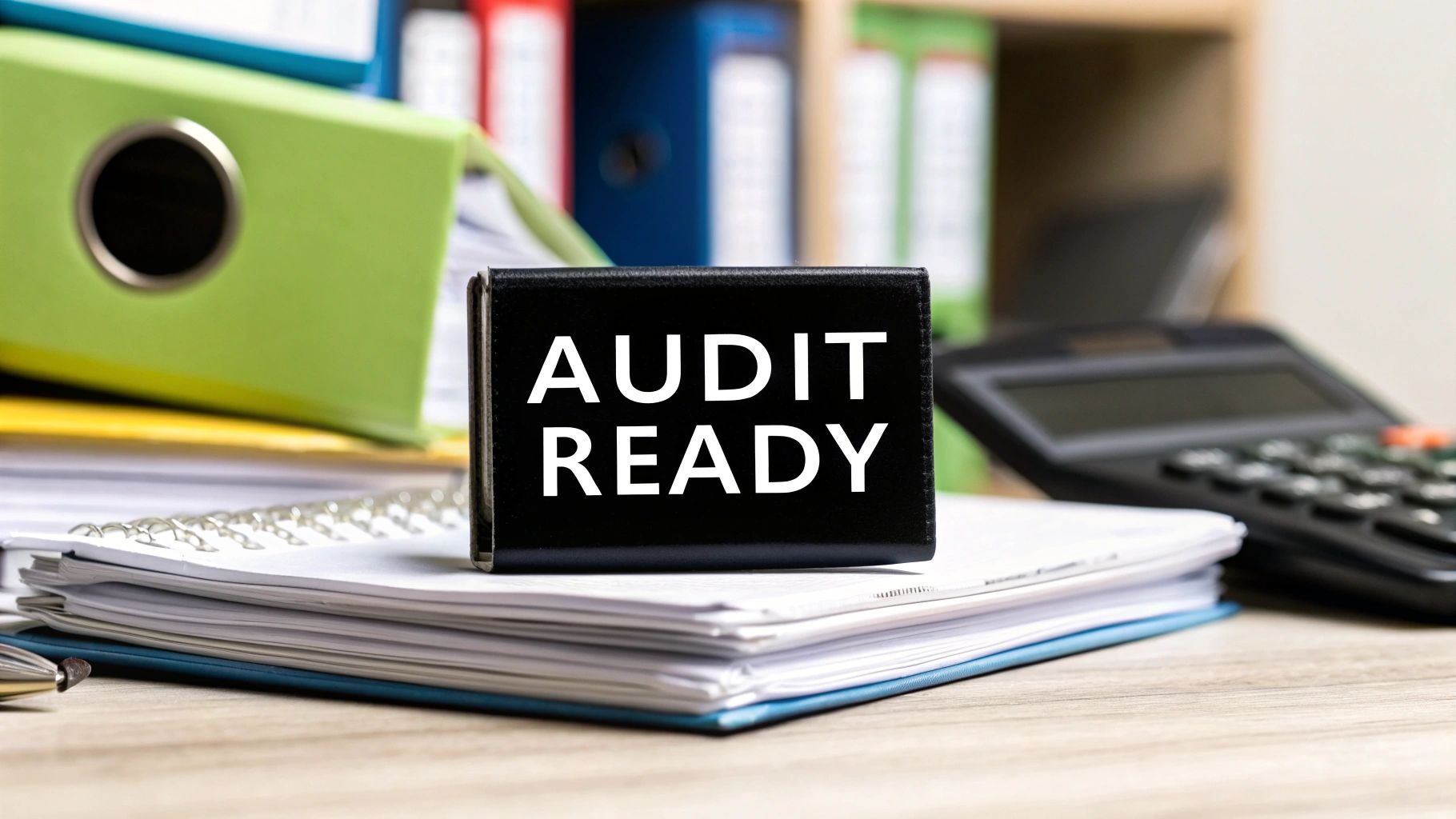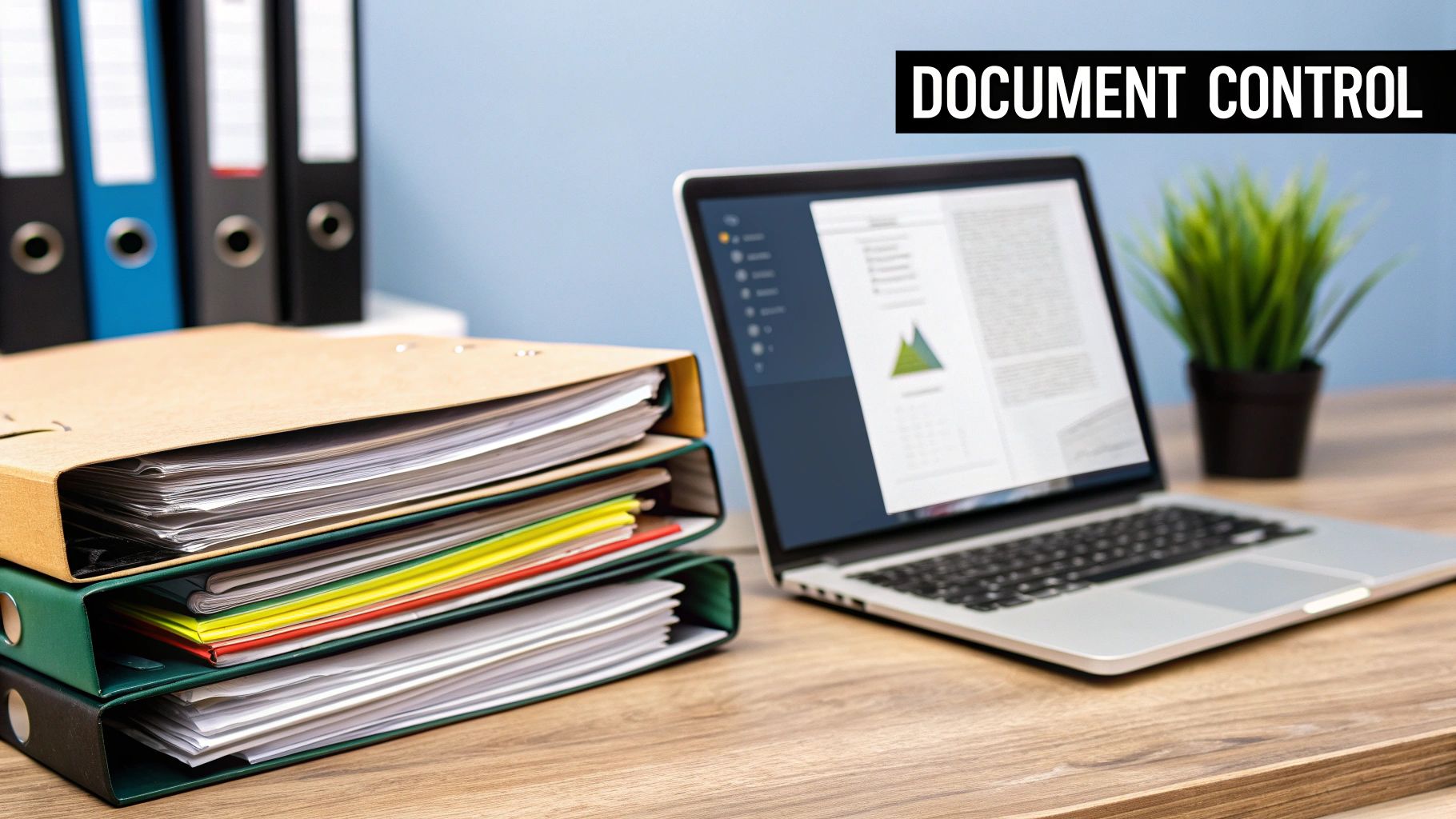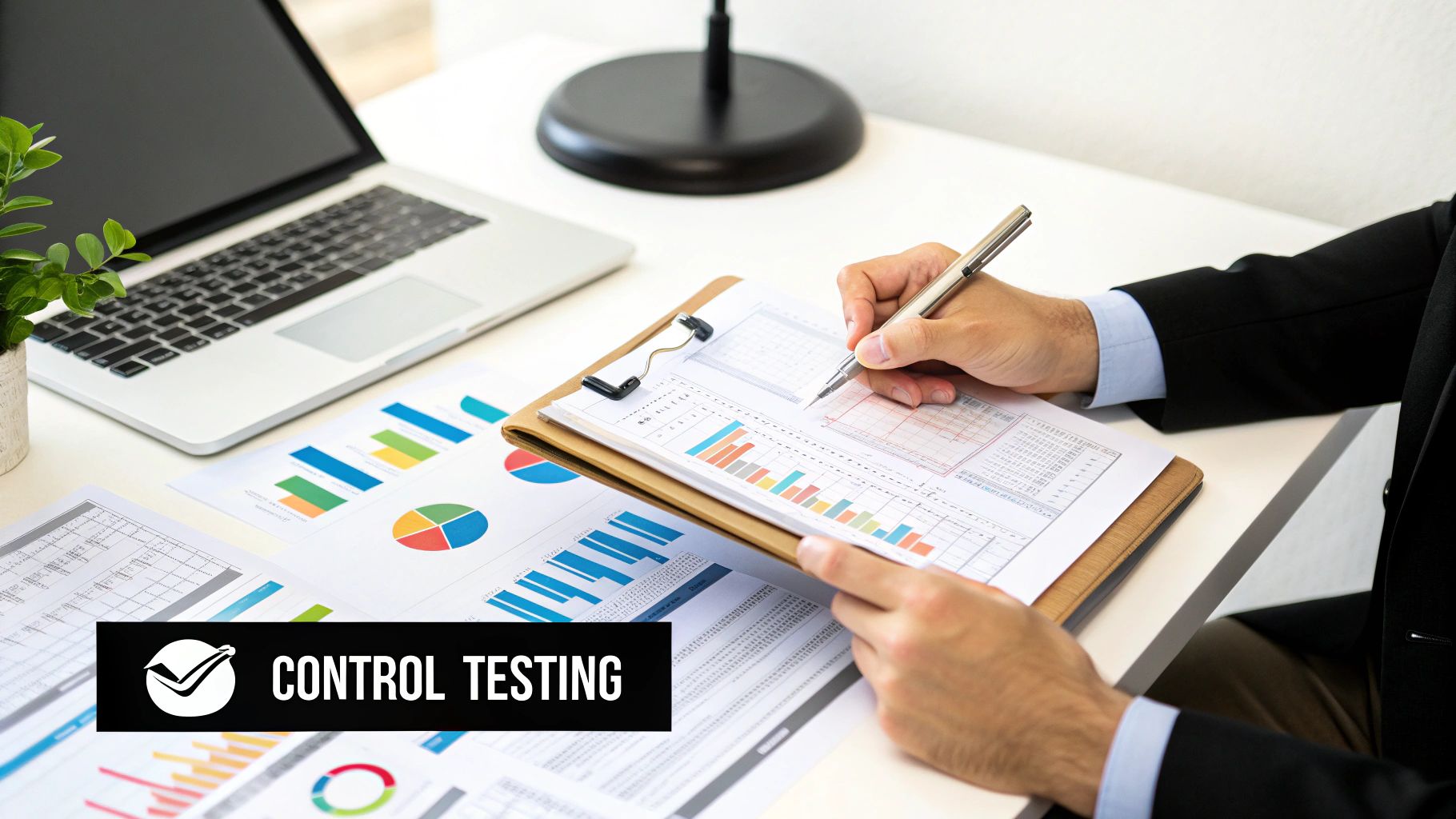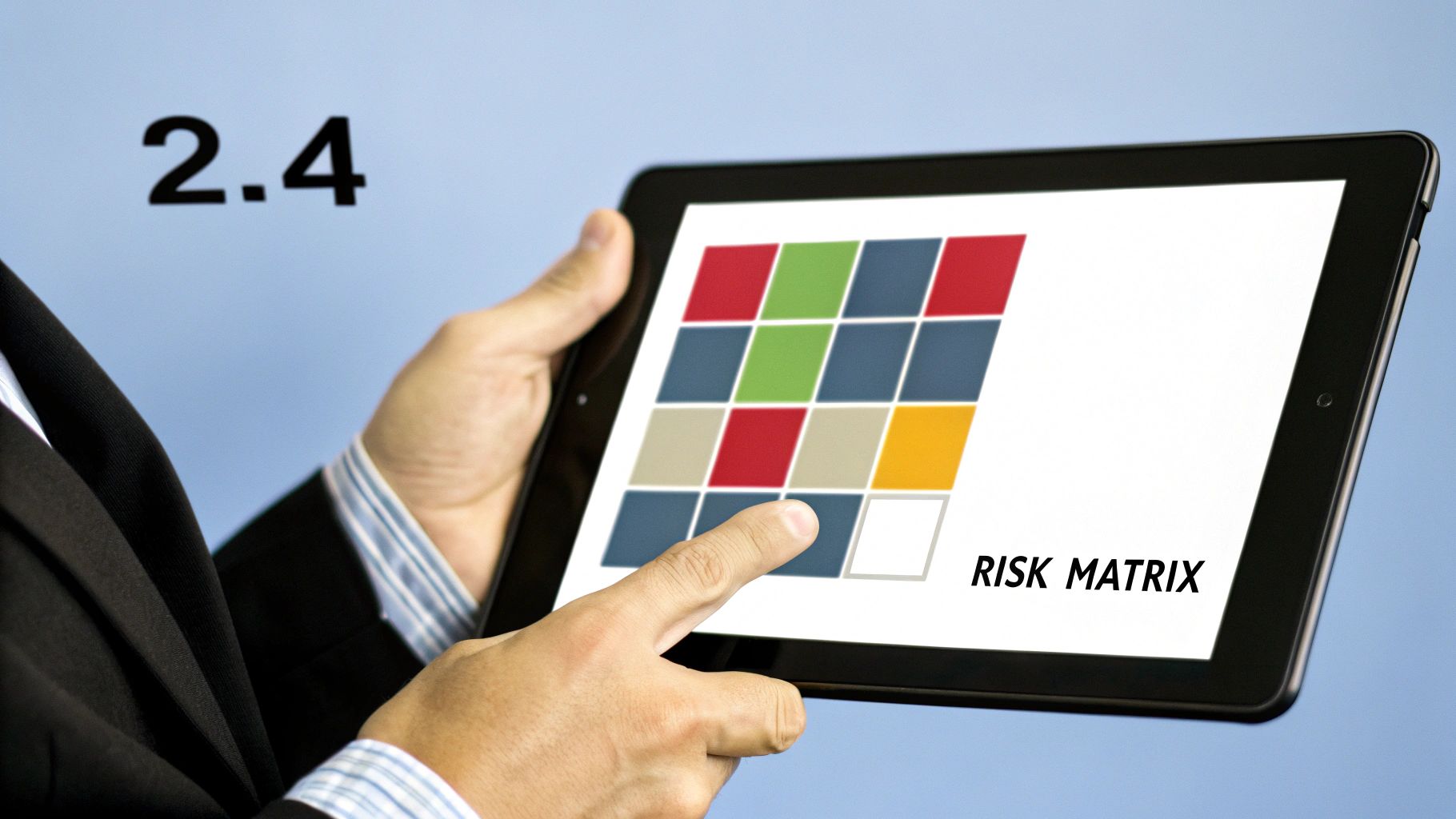Your Ultimate Audit Readiness Checklist: 8 Steps for 2025
Facing an audit? Our comprehensive audit readiness checklist guides you through 8 essential steps to ensure a smooth, efficient, and successful process.
Tags

The word 'audit' can send a shiver down the spine of even the most diligent business owner or finance manager. It often conjures images of late nights, endless document requests, and a magnifying glass held over every single transaction. But it doesn't have to be this way. A proactive approach can transform an audit from a dreaded ordeal into a valuable opportunity to validate your financial health and strengthen your internal operations. It’s about being prepared, organized, and confident long before the auditors arrive.
This article provides more than just a simple list of tips; it is a comprehensive, actionable audit readiness checklist designed to guide you through every critical stage of preparation. We will break down the eight fundamental pillars of audit readiness, from documentation management and internal controls to IT security and pre-audit communication. Think of this as your strategic roadmap to ensure you’re not just ready, but truly ahead of the game.
By following this guide, you will gain a clear, step-by-step framework to navigate your next audit with poise and precision. You'll learn how to implement robust systems, organize critical documentation, and communicate effectively with your audit team. Our goal is to help you turn a potential headache into a powerful business advantage, demonstrating the integrity and accuracy of your financial reporting. Let's dive in and build the foundation for a seamless audit experience.
1. Documentation and Record Management
At the heart of any successful audit readiness checklist lies a robust system for documentation and record management. This isn't just about keeping files in a cabinet; it’s about creating a comprehensive, organized, and easily retrievable library of all your business's critical documents. Think of it as the central nervous system for your compliance efforts, encompassing everything from financial statements and contracts to internal policies and procedures. A well-structured system ensures that when auditors ask for a specific record, you can produce it quickly and confidently, demonstrating control and transparency.

This approach has been popularized by major regulatory frameworks like the Sarbanes-Oxley Act (SOX) and quality standards like ISO 9001, which mandate stringent record-keeping. The core idea is to manage the entire lifecycle of a document: its creation, review, approval, distribution, storage, and eventual disposal, all while maintaining version control and secure access.
How to Implement Strong Record Management
Implementing an effective system doesn't have to be overwhelming. Start by prioritizing your most critical documents based on risk. For instance, financial transaction records and employee payroll data are high-priority.
- •Choose the Right Tools: For a small manufacturing company, a cloud-based system like Box or Dropbox with defined folder structures and user permissions can work wonders. Larger enterprises often leverage platforms like Microsoft SharePoint, which helped Microsoft reduce its own audit preparation time by an impressive 40%.
- •Automate Workflows: Implement automated workflows for routine processes like invoice approvals or policy updates. This not only saves time but also creates a digital trail that auditors can easily follow.
- •Tag Everything: Use metadata tags for all documents. Tagging invoices by vendor, date, and department, for example, makes searching for specific items instantaneous.
- •Train Your Team: A system is only as good as the people using it. Conduct regular training on proper document handling, naming conventions, and security protocols. For a deeper dive into modern solutions, you can explore the benefits of accounting document management software.
By establishing a clear and consistent documentation process, you transform a potentially chaotic task into a strategic asset. It shifts your audit posture from reactive scrambling to proactive confidence, making it a non-negotiable first step on your audit readiness journey.
2. Internal Controls Assessment and Testing
Beyond organized paperwork, a crucial element of any audit readiness checklist is a thorough assessment of your internal controls. These are the policies and procedures you put in place to safeguard assets, ensure the accuracy of financial reporting, and promote operational efficiency. Think of them as the guardrails for your business processes. A proactive assessment involves systematically reviewing these controls, testing their effectiveness, and fixing any weaknesses long before an auditor walks through the door. This demonstrates a commitment to integrity and sound governance.

This practice is heavily influenced by established frameworks like COSO (Committee of Sponsoring Organizations of the Treadway Commission) and mandated by regulations such as Sarbanes-Oxley (SOX) Section 404. The goal is to prove that your controls are not just designed well but are also operating effectively in practice. For example, after its high-profile account scandal, Wells Fargo was required to implement sweeping enhancements to its controls governing customer account management to regain regulatory trust.
How to Implement Strong Internal Control Testing
Assessing internal controls can be scaled to fit any organization, from a startup to a global corporation. The key is to be systematic and focus on what matters most. For instance, a small tech startup can implement basic but effective three-way matching for all purchase orders, invoices, and receiving reports to prevent unauthorized payments.
- •Prioritize with a Risk Matrix: Start by identifying your highest-risk areas, such as revenue recognition or inventory management. Use a risk assessment matrix to map processes based on their potential impact and likelihood of failure, focusing your testing efforts there first.
- •Document Everything: Clearly document each control, the procedure for testing it, the evidence gathered, and the results. This creates a transparent and defensible audit trail.
- •Rotate Testing Responsibilities: To maintain objectivity, avoid having individuals test the controls they are responsible for performing. Rotating testing duties among qualified staff helps ensure an independent perspective.
- •Establish Clear Escalation Paths: Define a clear process for reporting and remediating control failures. When a deficiency is found, there should be no ambiguity about who needs to be notified and what steps must be taken to correct it. More insights on building these frameworks can be found through resources from the Institute of Internal Auditors (IIA).
By rigorously testing your internal controls, you shift from a position of hoping they work to knowing they do. This proactive validation provides management and auditors with confidence in your financial reporting and operational integrity, making it an indispensable step in your audit readiness.
3. Financial Statement Preparation and Reconciliation
The core output of your accounting function, your financial statements, are the primary focus of any audit. Ensuring their accuracy, completeness, and timeliness is a critical component of any audit readiness checklist. This goes beyond just presenting a balance sheet and income statement; it involves a meticulous process of reconciliation, where every number is backed by detailed supporting schedules, analyses, and evidence. It means all transactions are recorded in the correct period, and all accounting estimates are reasonable and properly documented.

This rigorous approach is mandated by foundational frameworks like Generally Accepted Accounting Principles (GAAP) and International Financial Reporting Standards (IFRS), as well as by SEC reporting requirements for public companies. The principle is to create a transparent, verifiable link from the final financial statement figures all the way back to the individual source transactions. When auditors can clearly trace this path, it builds immense confidence in your financial reporting integrity.
How to Implement Strong Financial Preparation
A smooth and accurate financial close process is a hallmark of a well-run finance department. Start by standardizing your month-end close and reconciliation procedures to build a repeatable, auditable rhythm.
- •Standardize Everything: Implement standardized templates for all key account reconciliations, such as bank accounts, accounts receivable, and fixed assets. This ensures consistency and makes the review process for both internal teams and external auditors far more efficient. Walmart, for example, relies heavily on automated reconciliation to handle millions of daily transactions, a scale impossible without strict standardization.
- •Establish Clear Cut-Offs: Define and enforce strict cut-off procedures for period-end transactions. This prevents revenue or expenses from leaking into the wrong accounting period, which is a common source of audit adjustments.
- •Automate Where Possible: Use automated tools for high-volume reconciliations. A mid-size retailer, for instance, implemented an automated three-way matching system for its purchase-to-pay process, which reduced its month-end close time by 50% and significantly lowered the risk of errors.
- •Review and Analyze: Perform analytical reviews of your financial statements before finalizing them. Compare current results to prior periods and budgets to identify and investigate any unusual fluctuations or unexpected trends. This proactive analysis demonstrates strong internal controls. For more tips on this crucial process, you can find a helpful guide on essential bank reconciliation tips.
By treating financial statement preparation as a continuous, disciplined cycle rather than a once-a-year scramble, you ensure your records are always audit-ready. This approach not only satisfies auditors but also provides management with reliable, timely data for better decision-making throughout the year.
4. Compliance and Regulatory Requirements Review
Navigating the web of laws, regulations, and industry standards that govern your business is a critical component of any audit readiness checklist. This step involves a comprehensive review to ensure your organization isn't just aware of these rules but is actively adhering to them. It’s about building a systematic process to identify, interpret, and implement all applicable requirements, from broad financial mandates to niche industry-specific guidelines, and documenting every compliance effort along the way.

This proactive approach to compliance has been institutionalized by major frameworks like the Sarbanes-Oxley Act (SOX), which enforces strict internal controls for public companies, and industry-specific rules like the FDA's Good Manufacturing Practices. The goal is to create a living compliance program that not only meets current obligations but also adapts to regulatory changes, proving to auditors that compliance is embedded in your corporate culture, not just a last-minute scramble.
How to Implement a Strong Compliance Review Process
A systematic compliance review will prevent costly penalties and demonstrate operational integrity. You can start by mapping out all relevant regulations and assigning clear ownership for each.
- •Establish Regulatory Monitoring: Don't wait for a regulator to knock on your door. Use a subscription service or assign a team to monitor for changes in laws affecting your industry. For example, a restaurant chain must stay current with evolving food safety laws, while a fintech startup needs to track changes in consumer protection regulations.
- •Create a Compliance Calendar: A centralized calendar with key filing deadlines, reporting requirements, and training schedules keeps everyone aligned and accountable. This simple tool helps prevent missed deadlines and ensures recurring compliance tasks are completed on time.
- •Document Everything: Maintain a detailed log of all compliance activities. This includes records of training sessions, internal audits, policy updates, and any decisions made regarding regulatory interpretation. This documentation is your primary evidence for auditors. To effectively navigate the complex regulatory landscape, understanding and implementing the right measures is key. Explore these top strategies for regulatory compliance for banks for more in-depth guidance.
- •Train Your Staff Regularly: Conduct ongoing training to ensure all relevant employees understand their compliance responsibilities. A well-trained team is your first line of defense against non-compliance.
By embedding a continuous review of regulatory requirements into your operations, you shift from a position of risk to one of control. It demonstrates to auditors, stakeholders, and customers that your organization is built on a foundation of integrity and diligence, making it an indispensable part of your audit readiness strategy.
5. IT Systems and Data Security Audit Preparation
In today's digital-first world, your IT infrastructure is as critical to an audit as your financial ledgers. Preparing your IT systems and data security for an audit involves a comprehensive review of your technology environment to ensure data integrity, confidentiality, and availability. It’s about proving that you have the controls in place to protect sensitive information from unauthorized access, corruption, or loss. Auditors will scrutinize everything from user access rights to your disaster recovery plan, making this a pivotal part of any modern audit readiness checklist.
This focus on IT controls has been heavily influenced by frameworks like the NIST Cybersecurity Framework and compliance requirements such as SOC 2. These standards emphasize a proactive, risk-based approach to security. The goal is to build a resilient and secure IT environment where data is protected throughout its lifecycle, demonstrating strong IT governance to stakeholders and regulators.
How to Implement Strong IT and Data Security
A strong IT security posture is built on layers of technical and procedural controls. Start by identifying your most critical digital assets and the systems that support them.
- •Conduct Regular Security Assessments: Don't wait for an auditor to find your weaknesses. Proactively perform vulnerability scans and penetration tests to identify and fix security gaps. This proactive stance was a key part of Target's massive cybersecurity overhaul after its 2013 data breach.
- •Implement Layered Access Controls: Adopt a principle of least privilege, ensuring employees only have access to the data necessary for their roles. A small accounting firm can significantly boost security by implementing two-factor authentication (2FA) and encrypted backups. For larger organizations, Microsoft's Zero Trust security model is a powerful example of assuming no user or device is inherently trustworthy.
- •Maintain Detailed Logs and Monitors: Implement automated systems that monitor for and alert on suspicious activity. Keep detailed, immutable logs of all system access, changes to critical data, and administrative actions. These logs are your evidence of control. For comprehensive IT Systems and Data Security Audit Preparation, it's also vital to ensure your digital legal frameworks are robust. This includes understanding the importance of having well-crafted and compliant website privacy policies.
- •Test Your Recovery Plans: A backup plan is useless if it doesn't work. Regularly test your data backup and disaster recovery procedures to ensure you can restore operations quickly and completely in an emergency.
By systematically securing your IT systems and data, you're not just preparing for an audit; you're safeguarding the very foundation of your business. This demonstrates a mature approach to risk management and provides auditors with the confidence that your financial data is accurate and secure.
6. Risk Assessment and Management Framework
An essential component of any audit readiness checklist is a formal Risk Assessment and Management Framework. This isn't about eliminating all risk, an impossible task, but rather about establishing a structured approach to identify, evaluate, and proactively manage potential threats. It’s a strategic map that helps you navigate uncertainties that could impact your financial reporting, operations, or compliance. A well-defined framework demonstrates to auditors that your organization is not just reacting to problems but is actively anticipating and mitigating them.
This proactive stance is championed by globally recognized standards like the COSO Enterprise Risk Management Framework and ISO 31000. These frameworks provide a systematic process for understanding the full spectrum of risks, from market volatility and cybersecurity threats to internal fraud and regulatory changes. By embedding risk management into your culture, you create a more resilient and predictable business environment. An effective framework is also incomplete without strategies to proactively understand and mitigate legal challenges, ensuring you can actively work to better skydda ditt företag mot rättsliga risker.
How to Implement a Strong Risk Management Framework
Building a robust framework starts with a commitment from leadership and involvement across the entire organization. You can begin with a simple risk register and evolve it over time.
- •Prioritize and Focus: Don't try to tackle every conceivable risk at once. Start by identifying and analyzing high-impact, high-probability risks first. A small tech startup, for instance, might prioritize data security and key personnel dependency over supply chain disruptions.
- •Involve All Departments: Risk isn't just a finance issue. Your IT team understands cybersecurity threats, while sales can identify market risks. Involving multiple departments ensures a comprehensive risk identification process.
- •Establish Clear Ownership: Assign a specific owner to each identified risk. This person is responsible for monitoring the risk and implementing mitigation strategies, creating clear accountability. For example, JPMorgan Chase’s renowned framework assigns explicit ownership for credit, market, and operational risks.
- •Integrate Your Tools: Use software to track risks and mitigation efforts. Integrating these tools with your core systems provides real-time data and a more holistic view. To discover how this works in practice, you can explore the benefits of accounting software integration.
By developing and maintaining a dynamic risk management framework, you show auditors a high level of organizational maturity. It proves that your internal controls are not just for show but are directly linked to a strategic understanding of the challenges your business faces, turning potential vulnerabilities into managed and monitored aspects of your operations.
7. Audit Committee and Governance Structure
A strong governance structure, spearheaded by an independent and competent audit committee, serves as the ultimate line of defense in your audit readiness checklist. This isn't just a formality for public companies; it’s a critical framework that provides oversight for financial reporting, internal controls, and ethical conduct. Think of the audit committee as the board's dedicated team of financial stewards, ensuring that management's representations are accurate and that both internal and external auditors have the independence they need to perform their work effectively. A well-functioning committee demonstrates a top-down commitment to integrity and transparency, which auditors view very favorably.
This emphasis on governance was significantly amplified by regulations like the Sarbanes-Oxley Act (SOX), specifically Section 301, and is a core requirement for listings on exchanges like NYSE and NASDAQ. The principle is to create a check and balance system where an independent body with financial acumen challenges and verifies the company's financial processes, ensuring everything is above board. For a private company, adopting this structure signals a high level of maturity and discipline.
How to Implement Strong Governance
Building an effective audit committee and governance structure is a strategic move that instills confidence in stakeholders, from investors to auditors. It starts with selecting the right people and defining clear processes.
- •Ensure Committee Independence and Expertise: The committee should consist of independent, non-executive directors. At least one member must be a "financial expert," as defined by regulatory standards. Apple's audit committee is a prime example, composed of independent directors with deep financial and accounting experience from other major corporations.
- •Establish a Formal Charter and Regular Meetings: Document the committee's responsibilities in a formal charter. Schedule regular meetings with set agendas, including executive sessions where the committee meets privately with internal and external auditors without management present. This encourages open and honest dialogue.
- •Maintain Detailed Minutes: Meticulously record the minutes of every audit committee meeting. These documents serve as crucial evidence of oversight, detailing discussions, questions asked, and decisions made regarding financial reports and audit findings.
- •Provide Continuous Education: The financial and regulatory landscape is always changing. Provide ongoing training for committee members to keep them updated on new accounting standards, cybersecurity risks, and governance best practices. This ensures their oversight remains relevant and effective.
By establishing a robust governance framework, you're not just preparing for an audit; you're building a foundation of trust and accountability. It transforms oversight from a compliance checkbox into a strategic asset that safeguards the company's integrity and long-term value, making it an indispensable part of any audit readiness checklist.
8. Pre-Audit Communication and Coordination
A smooth audit is rarely an accident; it's the result of deliberate and proactive planning. This is where pre-audit communication and coordination come in, acting as the diplomatic groundwork for the entire engagement. It involves establishing clear, open channels with your external auditors well before they arrive, setting expectations, and aligning on logistics. Think of it as a pre-flight checklist for your audit, ensuring all parties are prepared, informed, and ready for a productive process, which is a critical part of any comprehensive audit readiness checklist.
This proactive approach, championed by standards from the American Institute of CPAs (AICPA) and the Public Company Accounting Oversight Board (PCAOB), transforms the audit from a feared inspection into a collaborative review. By managing logistics and expectations upfront, you prevent misunderstandings, minimize disruptions to your daily operations, and demonstrate a high level of organization and control to your auditors from day one.
How to Implement Strong Pre-Audit Coordination
Effective coordination begins months before the audit fieldwork. It's about building a partnership with your audit firm to ensure efficiency. For example, a regional bank reportedly reduced its on-site audit fieldwork by 25% simply by streamlining its pre-audit communication and document delivery process.
- •Establish a Single Point of Contact: Designate a specific person or small team within your company to be the primary liaison for the auditors. This prevents conflicting information and streamlines all requests. This is a tactic used by large corporations like Amazon to manage complex audits across various business segments.
- •Hold a Planning Meeting: Schedule a formal kick-off meeting to discuss the audit scope, timeline, key areas of focus, and required documentation. This is your chance to clarify any questions and align on the process.
- •Prepare an Audit Workspace: Set up a dedicated, secure space for the audit team, whether physical or virtual. Ensure they have access to necessary systems, files, and technological resources to perform their work without interruption.
- •Anticipate and Prepare Request Lists: Don't wait for the official "Provided by Client" (PBC) list. Based on prior years, proactively gather anticipated documents. This shows immense preparation and significantly speeds up the initial phase of the audit.
By laying this foundation, you set a positive and professional tone for the entire audit. It signals that your organization is transparent, organized, and serious about compliance, turning what could be a stressful period into a well-managed and constructive engagement.
Audit Readiness Checklist Comparison
| Item | Implementation Complexity 🔄 | Resource Requirements ⚡ | Expected Outcomes 📊 | Ideal Use Cases 💡 | Key Advantages ⭐ |
|---|---|---|---|---|---|
| Documentation and Record Management | High - setup and maintenance intensive | Moderate to high - technology and training | Streamlined audit processes, continuous compliance | Organizations needing centralized, controlled documentation | Reduces audit time/costs, improves compliance visibility |
| Internal Controls Assessment and Testing | High - specialized knowledge and time required | High - expert personnel and testing tools | Early identification of control weaknesses | Companies focused on operational risk and compliance | Reduces audit findings, improves process reliability |
| Financial Statement Preparation and Reconciliation | Moderate to high - skilled staff needed | High - accounting personnel and software | Accurate, timely financial statements | Firms requiring clean, defensible financial reporting | Lowers audit adjustments, speeds audit completion |
| Compliance and Regulatory Requirements Review | High - ongoing monitoring and expertise needed | Moderate to high - compliance specialists | Prevention of violations, regulatory adherence | Regulated industries managing multiple compliance areas | Builds stakeholder confidence, reduces audit scope |
| IT Systems and Data Security Audit Preparation | High - technical expertise and frequent updates | High - cybersecurity staff and tools | Strong IT governance and data security | Organizations with critical IT infrastructure | Protects against breaches, ensures data integrity |
| Risk Assessment and Management Framework | High - comprehensive, organization-wide effort | Moderate to high - cross-functional involvement | Proactive risk identification and mitigation | Enterprises aiming for mature risk management | Enhances decision-making, reduces audit surprises |
| Audit Committee and Governance Structure | Moderate - establishing roles and communication | Moderate - qualified independent members | Independent oversight and improved governance | Companies seeking strong corporate governance | Improves credibility, enhances auditor confidence |
| Pre-Audit Communication and Coordination | Moderate - requires detailed planning | Moderate - coordination and communication efforts | Reduced audit duration and minimized disruption | Organizations preparing for external audits | Builds positive auditor relations, enables early issue resolution |
From Checklist to Confidence: Your Path to Audit Success
Crossing the final item off a checklist always brings a sense of accomplishment. But when that list is your comprehensive audit readiness checklist, the feeling isn't just accomplishment; it's profound confidence. You've navigated the intricate landscapes of documentation, fortified your internal controls, and aligned your operations with rigorous compliance standards. This journey transforms the audit from a feared annual ordeal into a valuable opportunity to showcase your company’s financial health and operational integrity.
The true power of this checklist lies not in its completion, but in its integration. Audit readiness is a mindset, a continuous loop of improvement embedded into your organization's culture. It’s about making preparedness a daily habit, not a frantic, last-minute scramble.
Recapping Your Journey to Being Audit-Ready
Let's quickly revisit the critical pillars we've constructed throughout this guide:
- •Documentation and Record Management: We moved beyond just keeping records. We established a system for creating a clear, accessible, and verifiable paper trail for every single transaction, contract, and policy.
- •Internal Controls Assessment: You learned to not only design controls but to actively test and document their effectiveness, proving that your processes work as intended to prevent errors and fraud.
- •Financial Statement Preparation: This went from a simple reporting task to a meticulous process of reconciliation and validation, ensuring every number on your balance sheet and income statement is accurate and defensible.
- •Compliance and Regulatory Review: You’ve built a proactive framework to stay ahead of legal and industry-specific requirements, mitigating the significant risks of non-compliance.
- •IT Systems and Data Security: In our digital age, you now understand how to prepare your IT infrastructure for scrutiny, safeguarding sensitive data and demonstrating robust security protocols.
- •Risk Assessment and Management: Instead of reacting to problems, you are now actively identifying, assessing, and mitigating potential risks before they can impact your financial stability.
- •Governance and Communication: We highlighted the importance of a strong governance structure and clear, open lines of communication with your auditors, setting a collaborative tone from day one.
The Shift from Reactive to Proactive
The core theme connecting all these points is the strategic shift from a reactive to a proactive stance. A reactive company scrambles for documents, rushes to fix control gaps, and hopes for the best. A proactive, audit-ready organization, however, operates with a constant state of preparedness. Financial data is clean, controls are functioning, and documentation is already organized.
This proactive approach yields benefits that extend far beyond a clean audit report. It builds investor trust, improves operational efficiency, and empowers your team with clarity and accountability. When your financial house is in order year-round, you can make better strategic decisions, secure financing more easily, and navigate economic uncertainty with greater resilience.
Key Insight: Audit readiness is not a project with a deadline; it's an operational standard. The goal isn't just to pass an audit but to build an organization that is always auditable.
Embracing this audit readiness checklist is a commitment to excellence. It’s a declaration that your business values transparency, accuracy, and integrity. By implementing these structured practices, you are not just preparing for an external review; you are investing in a stronger, more credible, and more successful future for your company. Walk into your next audit not with apprehension, but with the quiet confidence that comes from knowing you are thoroughly and completely prepared.
Ready to eliminate the headache of manual document collection and ensure your records are pristine for your next audit? GetInvoice automates the capture and organization of every invoice and receipt, creating a perfect, audit-proof trail effortlessly. Visit GetInvoice to see how you can transform your documentation process from a major chore into a streamlined, automated, and audit-ready system.